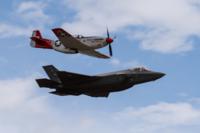For the first time in nearly 17 years, bright blue Union Jack flags commemorating a pivotal World War II battle will again fly high on Navy ships -- a move meant to symbolize U.S. naval might as adversaries pose new threats across the globe.
Chief of Naval Operations Adm. John Richardson announced the change to the Navy's official maritime flag on Thursday. The blue Union Jack flag, which features 50 white stars representing each state, will return to jackstaffs on June 4 in honor of the historic Battle of Midway.
"Make no mistake: we have entered a new era of competition," Richardson said in a statement. "We must recommit to the core attributes that made us successful at Midway: integrity, accountability, initiative and toughness."
The Union Jack will officially replace the First Navy Jack, the service's current maritime flag that features red and white stripes with a rattlesnake and the words "Don't Tread on Me." Navy ships began flying that flag in place of the Union Jack on Sept. 11, 2002, while fighting the Global War on Terror.
Sailors around the world will raise the Union Jack on all Navy ships at morning colors on June 4, according to Navy administrative message 039/19, which was signed by Richardson and details the changes.
There's just one exception: Only the Navy's oldest deployable warship -- the amphibious-command ship Blue Ridge -- will be allowed to fly the First Navy Jack.
"The Navy will reestablish the custom in which the commissioned ship in active status having the longest total period in active status, other than USS Constitution, will display the First Navy Jack until decommissioned or transferred to inactive status," Richardson wrote.
A version of the Union Jack first flew in 1777 and was updated with new white stars as more states joined the union. It symbolizes "the cumulative strength of our nation and of our Navy, where the whole is greater than the sum of its parts," Richardson said.
Displaying the flag is also a nod to the sea service's rich heritage.
"A version of the Union Jack flew when Commodore [Matthew] Perry formally established relations with the Empire of Japan. A version of the Union Jack flew in harbors around the world as the Great White Fleet circumnavigated the globe. A version of the Union Jack flew in ports throughout the Pacific as the Navy island-hopped its way across the vast ocean, and in the Atlantic as the Navy supported operations to liberate the European continent," Richardson said.
The Navy is a symbol that projects American values to the world, he added.
"For more than 240 years, the Union Jack, flying proudly from jackstaffs aboard U.S. Navy warships, has symbolized these strengths," Richardson said.
The new policy won't affect those who wear the First Navy Jack patch as an optional component on certain Navy working uniforms, according to the administrative message.
-- Gina Harkins can be reached at gina.harkins@military.com. Follow her on Twitter @ginaaharkins.














